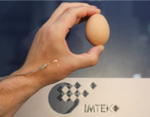On the road to the prosthesis of the future
Direktzugriff
Artikelaktionen
With the novel coding of current pulses, patients can also grip and move fragile objects more accurately. Photo: Thomas Stieglitz
Freiburg, Sep 25, 2018
Prostheses that feel and move less like a foreign body and more like a natural arm – an international research team headed by the Freiburg microsystems engineer Prof. Dr. Thomas Stieglitz has come one step closer to its goal. It has developed a special coding for current pulses that stimulate the nerves in the stump. The new procedure allows patients to more precisely grasp and move their arm prosthesis more naturally. The scientists published their results in the journal NEURON.
For the past few years, researchers have equipped hand prostheses with technical sensors. Through their use, people whose arm has been amputated can recognize the shape and strength of gripped objects by electro-stimulating the nerves in the stump. So far, however, the transmitted information has been far from providing a natural feeling and natural dexterity.
In the study, scientists developed a novel “stimulation code” through which the brain senses the power pulses as though the skin's natural sensors are producing them. As a result, the patient not only recognizes the gripping force and deformability of an object, but also grasps and moves it faster and more accurately. An interdisciplinary approach with methods from neurotechnology, clinical neurology, robotics and computer simulation have made it possible.
“To ensure the process was successful, we developed implantable electrodes in Freiburg that are thinner than a human hair. They remained stable in the nerves and did not move. As a result, current pulses could be transmitted to the nerves in a single encoding for months so that the two patients gradually adopted the prosthesis as their own arm rather than as a technical foreign body,” said Stieglitz, adding, “If I can grip raw eggs in a targeted fashion without anxiety while knowing where my hand is crushing them with just enough power, then the question is where the line between man and machine is.” In addition to improvements in feel, accuracy and dexterity, the biomimetic stimulation strategy also helps reduce phantom pain. The procedure can be transferred to other prostheses.
The European consortium includes researchers from the Sant'Anna School of Advanced Studies (SSSA) in Pisa, Italy, the Ecole Polytechnique Fédérale de Lausanne (EPFL) in Switzerland, the University of Freiburg and the Policlinico Gemelli in Rome, Italy. It is headed by Silvestro Micera, professor of bioengineering at SSSA and owner of the Bertarelli Chair in Translational Neuroengineering at EPFL.
Original publication:
„Biomimetic Intraneural Sensory Feedback Enhances Sensation Naturalness, Tactile Sensitivity, and Manual Dexterity in a Bidirectional Prosthesis“, Giacomo Valle, Alberto Mazzoni, Francesco Iberite, Edoardo D’Anna, Ivo Strauss, Giuseppe Granata, Marco Controzzi, Francesco Clemente, Giulio Rognini, Christian Cipriani, Thomas Stieglitz, Francesco Maria Petrini, Paolo Maria Rossini, Silvestro Micera, DOI: https://doi.org/10.1016/j.neuron.2018.08.033
Contact:
Prof. Dr. Thomas Stieglitz
Department of Microsystems Engineering (IMTEK)
University of Freiburg
Tel.: 0761/203-7471
E-Mail: thomas.stieglitz(at)imtek.uni-freiburg.de
Natascha Thoma-Widmann
PR/Marketing advisor
Faculty of Engineering
University of Freiburg
Tel: 0761/203-8056
E-Mail: thoma-widmann@tf.uni-freiburg.de
Fußzeile
Benutzerspezifische Werkzeuge

